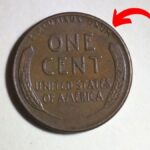What if the spare change in your pocket could be worth thousands or even hundreds of thousands of dollars ? This is not just a collector’s fantasy. In the world of numismatics, one humble coin the Lincoln Wheat Penny has stunned enthusiasts with its hidden value. Among these coins, a rare 1943 copper penny once fetched a staggering \$346,000 at auction. Even more intriguing? Some of these rare coins could still be circulating today, unnoticed and undervalued.
The Origin Story Lincoln Wheat Penny’s Historical Importance
First issued in 1909, the Lincoln Wheat Penny marked a monumental shift in U.S. coinage. For the first time, a real person President Abraham Lincoln was featured on American currency, replacing the traditional allegorical images like Lady Liberty. Designed by Victor David Brenner, the coin showcases Lincoln’s profile on the obverse and two wheat stalks on the reverse, symbolizing American agricultural strength.
This coin was minted until 1958, when the Lincoln Memorial design took its place. Billions of Wheat Pennies were struck, but only a handful became ultra-rare and highly sought after by collectors.
The 1943 Copper Penny Born from a Wartime Error
The most valuable Lincoln Wheat Penny owes its worth to a historical error. During World War II, copper was reserved for wartime production, prompting the U.S. Mint to switch penny composition from copper to zinc-coated steel in 1943. However, a few copper planchets from 1942 were mistakenly left in the presses, resulting in the creation of copper pennies in 1943.
Estimates suggest that only 20 to 40 of these copper 1943 pennies were ever minted. One of these coins later sold for \$346,000, making it one of the most coveted coins in American history.
How to Spot a Valuable Lincoln Wheat Penny
Not all Wheat Pennies are created equal. Here’s what you need to look for:
- 1943 Copper Penny: The holy grail. Check if it’s non-magnetic (unlike steel), and weighs about 3.11 grams (copper).
- 1909-S VDB: One of the first Lincoln pennies, with a mintage of only 484,000.
- Value: Up to \$50,000.
- 1914-D: A key date coin. Value: \$5,000–\$30,000.
- 1922 No D: A Denver mint coin missing its mint mark.
- Value: Over \$10,000.
- 1955 Doubled Die: Famous for its visible doubled lettering. Value: \$1,500–\$10,000.
Be on guard against counterfeits. Some con artists alter 1948 pennies to mimic the rare 1943 by tampering with the last digit. Always examine the date closely and test it against reliable resources or consult a professional.
The Hunt Valuable Pennies Might Still Be Out There
What makes this story even more exciting is that these valuable coins could still be in circulation. Many of them have slipped through decades of change jars, wallets, bank rolls, and piggy banks waiting to be found.
- Some have turned up in penny rolls from banks.
- Others were discovered in garage sales, old jars, or even estate sales.
- There are even stories of people unknowingly spending rare pennies worth thousands only realizing later what they had lost.
What to Do If You Think You Found a Rare Penny
If a coin in your possession checks all the boxes, handle it with care:
- Do not clean the coin. Cleaning can damage its surface and decrease its value dramatically.
- Use gloves or hold it by the edges to avoid fingerprints and skin oils.
- Get the coin authenticated. Trusted numismatic dealers or professional grading services like PCGS or NGC are your best bet.
- If verified, sell through reputable auction houses or certified dealers, not shady online listings.
Why This Penny Still Matters
The story of the \$346,000 Lincoln Wheat Penny has helped fuel a resurgence of interest in coin collecting, especially among younger hobbyists and first-time collectors. It’s not just about the money it’s about history, mystery, and the possibility that something extraordinary could be hiding in plain sight.
This coin represents more than just a piece of metal it’s a piece of American heritage, a glimpse into a different era, and a reminder that value is often hidden in the everyday.
Keep Checking Your Change
While it’s unlikely you’ll stumble upon a \$346,000 penny during your next grocery run, the thrill of the search is real. Checking your coins could not only be rewarding financially, but also open the door to a fascinating and educational hobby.




